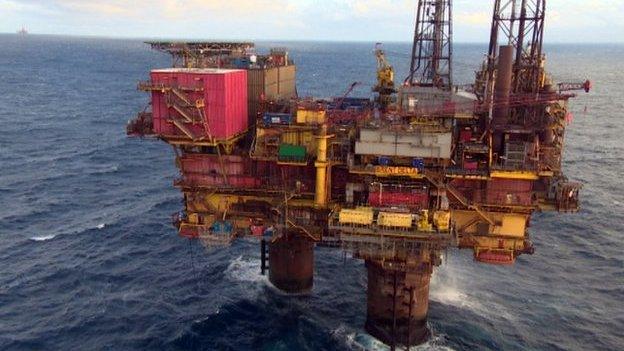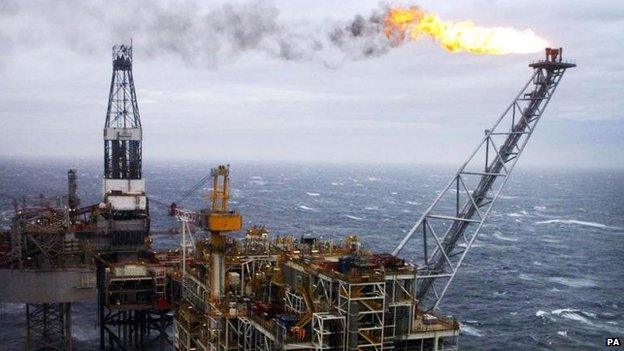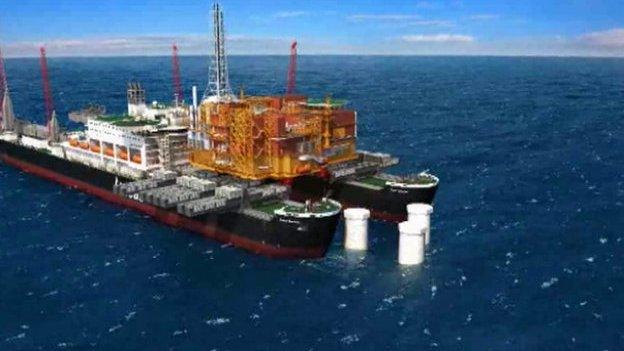The world's biggest scrapyard
- Published

The upside of the downturn in the oil industry is a gigantic business opportunity to break up all that equipment in the North Sea.
Shell is today setting out plans to break up its Brent field platforms, after nearly 40 years of being battered by the elements.
As BBC Scotland's Kevin Keane explains, it takes a lot of planning to remove the topside, and a whole lot more for the jacket and seabed storage tanks.
To do the job, the double-hulled, Swiss-owned Pieter Shelte has recently arrived in the North Sea from South Korea, capable of lifting 48,000 tonnes of topside, and a 25,000 tonne jacket.
(Its name, crewing and Panamanian flag are rather less awe-inspiring to the RMT trade union, which points out it is named after a Nazi war criminal).
Now, multiply that Brent Delta by 475 other offshore installations, 5,000 wells, 10,000km of pipelines and 15 onshore installations. And more are now being installed east and west of Shetland, which will need removed after a few more decades.
I was writing about this big economic opportunity in the world's biggest scrapyard more than four years ago, and about the giant ships being built to lift equipment.
When I wrote that, the estimated cost of decommissioning had just risen from £19bn to £27bn. It has most recently been put at £37bn, spread out until 2040. But it has been slow to get started, while the oil price has remained high.
Recycled rigs

Oil & Gas UK, representing the industry, published its projections before the rapid slide in the price of Brent crude, and it reckoned that the £900m spend on decommissioning last year will rise to an annual average of £1.3bn for the rest of this decade, peaking at £1.7bn next year.
That schedule may change a lot if fields are becoming less economic. The boss of BP has today said that he's heard, anecdotally, a third of North Sea fields are now running at a loss.
BP has confirmed plans to cut back harshly on its capital expenditure plans for this year, down by between £2.6bn and £4bn to less than £14bn. The value of its global reserves has been slashed by £2bn, and those of fellow UK energy company BG Group by £4bn.
For these big oil companies, the North Sea is among the more mature and least profitable of basins. In trying to cut costs, at least two companies plan a rota change from working two weeks on and two weeks off, to a three-week turnaround.
And where fields are getting old, much more decommissioning could be brought forward.

Oil platform lifted by two ships
Who gets the work?
Teesside seems to be in the lead. Shell intends to send its equipment for breaking up and recycling on a quay at Hartlepool yard.
Norwegian yards are also poised to grab a share.
The facilities, supply chain and expertise can be found in Scotland, but they appear to be lagging somewhat.
Skittish
The argument that the decommissioning boom will be brought forward depends on that oil price remaining low. Yet it's bouncing back. Having fallen close to $45 last month, it's now trading above $56.
"People are very, very skittish," according to one trader.
If there's one explanation for the rise, it is the self-correcting nature of the oil glut.
Oil exporters, led by Saudi Arabia, have kept pumping rather than cutting supply to support price. The price fell.
Data published last Friday showed the industry quickly cut back on the number of shale rigs at work in North America. That should feed through to falling supply in about nine months, as pressure runs down in the shale seams.
For BP and others, there's less money being put into exploration, and that will feed through to less supply in a few years.
It's expected that some expensive fields will be plugged earlier than planned. So taken together, there are lots of reasons why supply will fall. And so the price can be expected to rise again.
Harsh winter
However, don't expect it to be without bumps along the road. The harsh winter in America is boosting demand for heating oil. There are huge inventories being built up, with marine tankers now being used to store oil in anticipation of a higher price, and that in itself depresses the price.
If the price lifts to about $70 per barrel, you can expect those fracking rigs to become viable once more, and they can quickly be put back to work.
While the price will surely remain volatile, that seems a more comfortable equilibrium price on which exporting companies can get along with their American competitors.
It's unfortunate for the North Sea, meanwhile that the long-term break even point for a significant number of oil fields is above $70.
And after this week's Aberdeen summit of oil industry leaders and Scotland's two governments, it's worth remembering that all the talk of tax cuts in next months' Budget may be not only too late, but of little consequence.
If oil fields are not profitable, then there is no profit on which to levy tax.